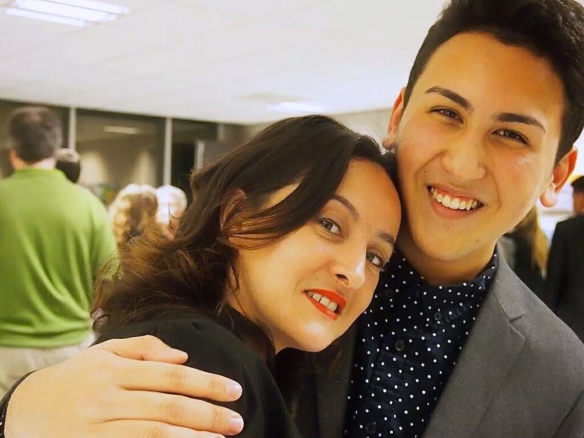When Malaysia Airlines Flight 17 went down, major news organizations
across the world rushed out profiles of the victims. In a memo to staff,
Senior Managing Editor Michael Oreskes explores why one AP story resonated around the world:

Amid all of these who-were-they stories, how did Kristen Gelineau‘s
narrative strike so deep, touching so many hearts, prompting so many
reader tears and accolades? A typical tweet urged, “EVERYONE needs to
read this!”
But why, exactly?
The answer may serve as guidance for any
number of future AP narrative-behind-the-news pieces and explains why
Gelineau’s story is the Beat of the Week.
Some 298 people perished when Flight 17,
en route from Amsterdam to Kuala Lumpur, was shot down as it passed
through the airspace of strife-torn Ukraine.
Gelineau, AP’s Sydney-based bureau chief
for Australia, New Zealand and the South Pacific, quickly went to work
on “The Final Hours.” Its title reflected an organizing principle from
the start: This would be a story showing how selected passengers
happened to be on the doomed flight, how they’d spent the time before it
took off. It would be a narrative, offering a glimpse of real lives, of
scenes and characters, not just locations, names and occupations.

In
this undated photo released by the Calehr family, Samira Calehr, left,
poses with her son Shaka Panduwinata. Shaka Panduwinata and his brother
Miguel Panduwinata, were killed aboard Malaysia Airlines Flight 17,
which was shot down over eastern Ukraine. (AP Photo/The Calehr family)
“We were looking for quality, not quantity,” said Mary Rajkumar,
assistant international editor, referring to notes she and Gelineau
sent to international regional editors and then individual reporters,
requesting help.
One note said: “The quality of the
tick-tock and whether we can pull it off will depend hugely on the
contributions we get, especially on the details. We’re looking for the
little things _ what they did that day, what their usual routine was,
what they ate, their last conversation, the last person they saw, what
they were like, etc.”
Gelineau requested further specifics, down to the time stamp on a last communication.
“Everyone really went the extra mile to
get these details: putting in extra calls and having to ask grieving
loved ones to look at emails from their dead relatives,” Gelineau said.
Supplementing her reporting were Nick Perry in Wellington, New Zealand; Jim Gomez in Pagbilao, Philippines; Firdia Lisnawati in Bali, Indonesia; Mike Corder in The Hauge, Netherlands, and Eileen Ng in Kuala Lumpur, Malaysia, who jumped in to help while on maternity leave. Lisnawati, Gomez and Gary Chuah shot photos, which ran along with images contributed by families. Video was by Jakarta’s Fadlan Syam and Berlin’s DorotheeThiesing.
So it was that readers learned of Rob
Ayley, a New Zealander who’d coped with Asperger’s syndrome from youth
but who’d become a father and husband and successful dog breeder who was
returning from a business trip touring European kennels; and of Willem
Grootscholten, who happily boarded the flight to begin a new life after
meeting Christine, a single mother in Bali whose children had come to
call him “Daddy”; and of Irene Gunawan, the 53-year-old sparkplug of her
Philippine family, who was headed for a reunion in a suburban Manila
neighborhood called “Heaven.”
And there were others.
Gelineau pursued a profile that became the backbone of the story, that of Miguel Panduwinata,
an 11-year-old who was traveling with his older brother to visit their
grandmother _ and who had been raising ominous questions in the days
before the flight.
“What would happen to my body if I was
buried?” the normally cheerful boy asked his worried mother. “Would I
not feel anything because our souls go back to God?”
Working from names on a flight manifest,
Gelineau tracked down an uncle of the boy by phone as he arrived in
Amsterdam. She interviewed him about his nephew (“He told me about
Miguel’s eerie premonition and the hairs on my arms stood up.”) Then,
over a couple of days, she gently persuaded him to put her in touch with
his sister, the boy’s mother, for a 40-minute phone interview finally
arranged at 2:30 a.m. Gelineau’s time.
“She kept saying, ‘I should have listened
to him.’ I knew immediately that was the end of my story,” Gelineau
said. “And I knew Miguel was going to be the beginning.”
Gelineau’s story was supplemented by an
abridged version _ but not simply a truncating of the original. “There
was no way to abridge six examples into 700 words and have any
characters really come across,” Rajkumar said. “So we offered our single
best anecdote instead as a shorter option, calling it The Boy Who Knew.
The response to the story — which was published around the world and
shared widely on social media and mobile — was extraordinary.
Thousands of readers commented, many saying they were in tears as they wrote.
“The glimpses into the lives of these
people, esp. Miguel, their loved ones, favorite foods, sports, made it
all too real, almost as if I knew them,” said one.
Another offered thanks “for dedicating the
time and space to this heart breaking, and yet heart warming glimpse
into the photo albums of these precious lives.” This reader hoped that
each family personally affected “has the chance to treasure this story.”
Many did, as notes from some victims’ loved ones made clear.
Rob Ayley’s mother wrote that she’d
include the story in a “memory box” she was putting together for her
son. The girlfriend of another victim wrote, “Thank you so so much from
the deep deep deepest bottom of our hearts.” And the uncle of Miguel
said talking about the boy and his brother for the story had been
therapeutic for the family, a source of strength.
For combining exemplary craft and compassion to achieve a distinctive kind of world beat, Gelineau wins this week’s $500 prize.
Δεν υπάρχουν σχόλια:
Δημοσίευση σχολίου